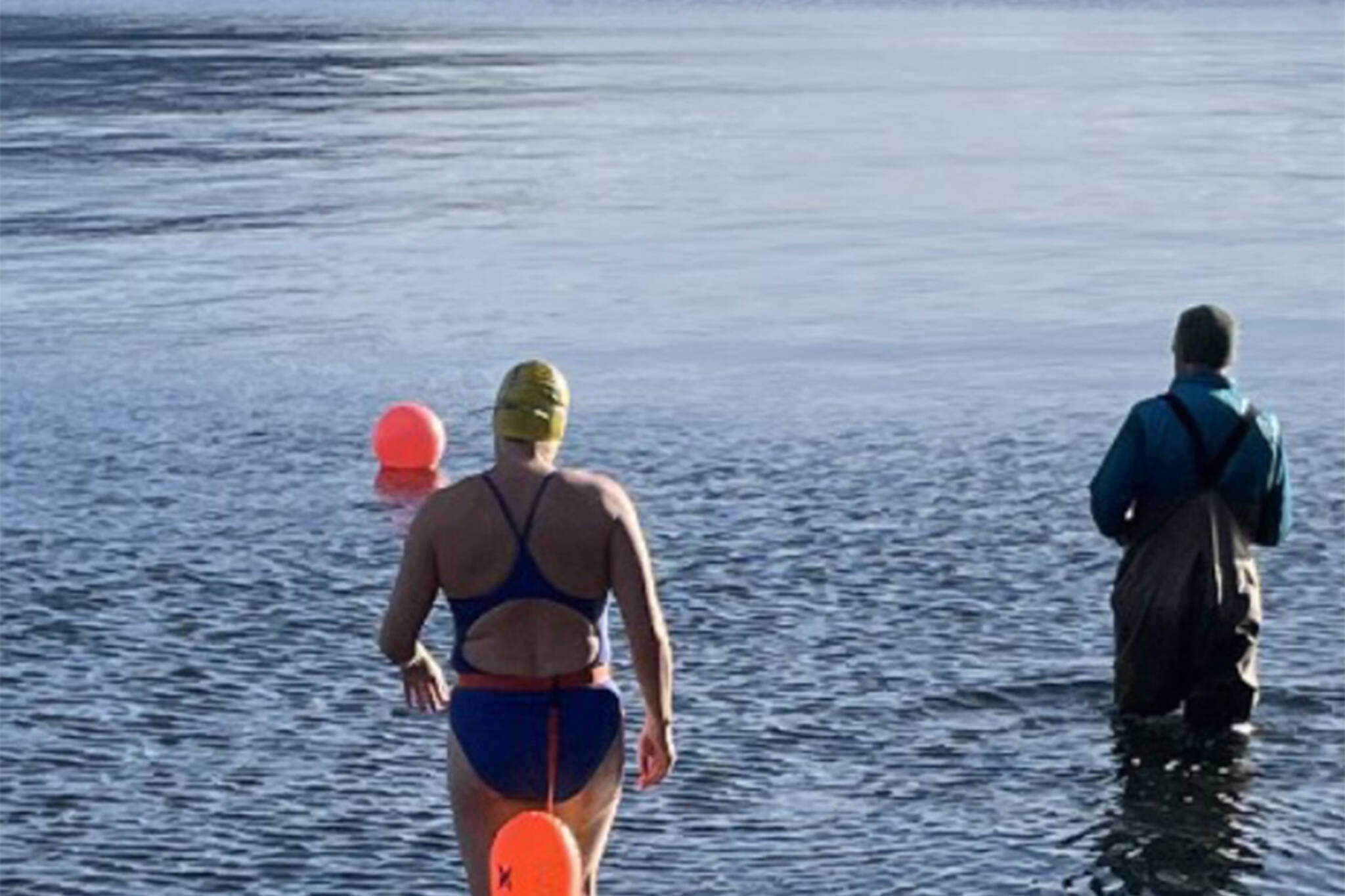Longtime Juneau resident Cheryl Fellman has run a marathon, hiked the Appalachian Trail, climbed large mountains and completed challenging open-water swims. Now, this mother of two is on the verge of becoming one of only 43 Americans — and 422 people worldwide — to swim an official Ice Mile.
Last week, in the chilly waters of Auke Bay, Fellman completed the swim that qualified her to try for the designation. The process involved taking three water temperatures and different depths and completing a standard British mile while wearing only a bathing suit, a swim cap and goggles.
“It’s nice to challenge these preconceived notions of what your limitations are,” Fellman said in a phone interview Monday morning. “It’s more mental endurance than a physical challenge.”
The International Ice Swimming Association, organized in 2009 to make ice swimming an official sport, describes the “Ice Mile” as the sport’s “ultimate achievement.”
Fellman hopes to complete her official swim soon—but timing depends on the weather and the water temperature.
To qualify as an Ice Mile, the swim must occur in water where the temperature is 41 degrees or lower. Swimmers must be unassisted, wear only a standard bathing suit, one pair of goggles and a standard silicone swimming cap.
[Scaring up Halloween fun for big kids and adults]
Training
Fellman said her interest in ice swimming started a few years ago when she traveled to Vermont to compete in an ice swimming race.
Her latest effort sprung from a goal set in January to swim outside and train for an event in February.
“The event came and went in February and it became evident that my body was favorably responding, and I was acclimating to the cold,” she said, explaining her decision to stick with it.
Fellman continued to train over the spring and summer, gradually increasing her time in the water and swimming distances.
She described the training process as a “song and dance.” She shuffles her time and distance based on the water temperature, she said.
“Back in February, I may have been in the water for five minutes and shivered for 25 minutes,” she said. “It’s been a process of very slowly acclimating your body so you know what to expect.”
She said she’s followed a methodical training plan and adheres closely to the rules set forth by the International Ice Swimming Association.
“Trying to attempt an Ice Mile is not something you just do. You do it by increasing the time and distance in the water in small increments,” she said.
“One of the things that happens if you haven’t been in cold water, is that you gasp in. That goes away. You don’t have the same level of shock,” she said, noting that she’s able to get in and start swimming more quickly now than she could when she started training.
Fellman said the actual swim is enjoyable. She recalled seeing hundreds of starfish on the ocean bottom during a recent swim.
“I love the mindfulness it brings. You physically can’t think of anything while you are swimming,” she said. “For that amount of time, everything shuts down. It’s very peaceful and gives you a high. You are chilled out.”
The after drop
Fellman said she feels great right after she gets out of the water. About 10 minutes later, a phenomenon known as the “after drop” occurs.
She explained that the after drop occurs because the cold blood in her arms and legs starts to cycle through her body. She said that the more she trains, the less harsh the after drop becomes.
“It felt like someone plugged a cold hose into my fingers. I don’t feel that now,” she said.
Fellman said she took careful notes to monitor her recovery phase after each swim.
It takes a team
Fellman said that when she makes her official attempt to complete the Ice Mile, a support team will help her. She said the team includes an observer who is familiar with the rule book and what it takes to make the swim official. A photographer and videographer will document her swim and the after-drop phase.
A second witness serves as an observer, people beside her in a kayak will keep a close eye on her stroke and watch for any safety concerns. An on-site medical officer will oversee her recovery.
“The thinking just doesn’t happen when you first get out,” she said, noting that her team steps in to make sure she has everything she needs to start the recovery.
“They just know what to do to get you up and out of there and up to the heated car,” she said, adding that her qualifying swim earlier this week provided an opportunity to work out any kinks with the plan.
[I Went to the Woods: The two types of climate change]
Making it official
Fellman said she’s already completed the paperwork to certify that she’s healthy enough to make the swim. Now, she’s just waiting on the weather.
With the qualifying swim behind her, she will be ready to go when the water temperature gets low enough.
“Honestly, we can go through the process and it’s only an attempt at that point. It’s not official until it’s been approved and ratified by international ice swimming,” she said.
Once she completes this challenge, she said she might be interested in seeking a new one.
• Contact reporter Dana Zigmund at 907-308-4891 or dana.zigmund@juneauempire.com.


